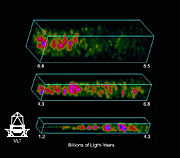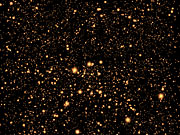Tisková zpráva
Temná energie v novém světle
Průzkum kosmické pavučiny
30. ledna 2008
S pomocí VLT změřili astronomové polohu a pohyb tisíce galaxií vzdáleného vesmíru. Na základě tohoto pozorování se tak otevřely dveře k poodhalení příčiny zrychlování expanze vesmíru a k lepšímu pochopení záhadné temné energie, jež se rozprostírá napříč celým vesmírem.
„Jednou z nejživějších otázek součané kosmologie je nalezení hlavní příčiny zrychlování expanze vesmíru,“ říká Luigi Guzzo, autor článku v Nature, kde jsou výsledky studie uveřejněny. „V průzkumu poloh a rychlostí vzdálených galaxií jsme objevili novou a účinnou možnost, jak vyřešit tuto záhadu.“
Před deseti lety astronomové zjistili, že se dnešní vesmír rozpíná rychleji, než tomu bylo v minulosti. „V současnosti existují dva zcela rozdílné pohledy na tuto problematiku,“ vysvětluje Enzo Branchini. „Buď je vesmír vyplněn záhadnou temnou energií, která působí proti gravitační síle, jež zpomaluje expanzi vesmíru, nebo je náš dnešní pohled na gravitaci mylný a je třeba jej změnit, například doplněním o další rozměry.“
Na základě současných pozorování rozpínajícího se vesmíru nelze přesně rozlišit, je-li platná ta či ona teorie. Mezinárodní tým 51 astronomů z 21 institucí však našel způsob, který může napomoci vyřešit tento problém. Technika je založena na pozorování zdánlivých rychlostí vzdálených galaxií. Na velikosti rychlosti se podílejí dva faktory. Jedním je celkové rozpínání vesmíru, kterým se galaxie navzájem vzdalují, a na druhé straně je to gravitační přitahování hmoty v galaxiích, kterým je formována velkorozměrová pavučinová struktura vesmíru.
„Měření zdánlivých rychlostí u velkého počtu galaxií, které probíhalo v posledních třiceti letech, nám umožnilo zrekonstruovat trojrozměrnou mapu rozložení těchto galaxií ve velkém objemu vesmíru. Mapa odhaluje velkorozměrové útvary jako kupy galaxií či filamenty nadkup,“ říká Olivier Le Fèvre. „Ze získaných informací jsme schopni určit skutečný pohyb galaxií. Zde nalézáme mírné, ale důležité odchylky. Měřením těchto odchylek v různých vzdálenost, a tedy i v různých obdobích vesmíru, můžeme zkoumat povahu temné energie."
Guzzo se svými spolupracovníky použili k tomuto měření spektrograf VIMOS na Melipalu, jednom ze čtyř 8,2 m dalekohledů VLT. V rámci VIMOS-VLT Deep Survey (VVDS), kde je Le Fèvre šéfem výzkumného týmu, byla prozkoumána spektra několika tisíc galaxií v poli o úhlové ploše čtyř čtverečních stupňů na obloze (neboli ploše dvaceti měsíčních kotoučů). Glaxie jsou zkoumány v období, kdy byl vesmír o polovinu mladší (tj. přibližně před 7 miliardami let).
„Jedná se o největší spektrograficky pozorovanou oblast v takovéto vzdálenosti,“ prohlašuje Le Fèvre. „K dnešku jsme z tohoto pole získali více jak 13000 spekter a celkový objem prozkoumaného vesmíru čítá více jak 25 miliónů světelných let krychlových.“
Napozorovaná data byla srovnána s výsledky průzkumu 2dFGRS, kde byl zmapován blízký vesmír, tzn. měřeny odchylky v pohybech galaxií v současnosti.
I přes jistou chybu měření z výsledků vyplývá, že je potřeba přimíchat do „vesmírné polévky“ extra energii, známou jako temná energie. V rovnicích je zahrnuta v podobě kosmologické konstanty, jež byla poprvé zavedena Albertem Einsteinem. Z důvodu velikosti chyby měření však zatím nemůžeme vyloučit ani jiná vysvětlení v rámci jiných teorií.
„Pokud zahrneme do pozorování vesmír o desetkrát větším objemu než u VVDS, můžeme touto technikou rozhodnout, zdali je urychlování rozpínání vesmíru způsobeno temnou energií neznámého původu nebo je potřeba změnit zákony gravitace,“ vysvětluje Guzzo.
„VIMOS na VLT by mohl být úžasným nástrojem pro tuto práci a pomohl by nám zodpovědět jednu ze základních otázek dnešní vědy. Vědecká komunita tak má vážné důvody k dalším ambiciózním průkumům vzdáleného vesmíru,“ uzavírá Le Fèvre.
Poznámky
The VLT VIsible Multi-Object Spectrograph (VIMOS) can observe spectra of about 1,000 galaxies in one single exposure. This cosmology science machine is installed at the 8.2-m MELIPAL telescope, the third unit telescope of the Very Large Telescope (VLT) at the ESO Paranal Observatory.
The VIMOS VLT Deep Survey (VVDS) is a breakthrough spectroscopic survey aiming at providing a complete picture of galaxy and structure formation over a large fraction of the Universe's history, covering sixteen square degrees of the sky in four separate fields
Složení týmu: L. Guzzo, A. Iovino, and O. Cucciati (INAF-Osservatorio Astronomico di Brera, Merate, Italy), M. Pierleoni, J. Blaizot, G.De Lucia, and K. Dolag (Max Planck Institut für Astrophysik, Germany), B. Meneux, B. Garilli, D. Bottini, D. Maccagni, M. Scodeggio, P. Franzetti, P. Memeo, and D. Vergani (INAF-IASF, Milano, Italy), E. Branchini (Universita Roma III, Italy), O. Le Fèvre, V. LeBrun, L. Tresse, C. Adami, S. Arnouts, A. Mazure, and S. de la Torre (Laboratoire d'Astrophysique de Marseille, OAMP-CNRS - Université de Provence, France), A. Pollo (Laboratoire d'Astrophysique de Marseille, OAMP-CNRS - Université de Provence, France and Andrzej Soltan (Institute for Nuclear Research, Warsaw, Poland), C. Marinoni (Centre de Physique Théorique, CNRS-Université de Provence, Marseille, France), S. Charlot (Institut d'Astrophysique de Paris, CNRS-Université de Paris 6, France), H. J. McCracken (Institut d'Astrophysique de Paris, CNRS-Université de Paris 6, and Laboratoire d'étude du rayonnement et de la matière en astrophysique, CNRS - Observatoire de Paris, France), J. P. Picat, T. Contini, R. Pellò, and E. Perez-Montero (Laboratoire d'Astrophysique de Toulouse et Tarbes, OMP-CNRS-Université de Toulouse 3, France), G. Vettolani and A. Zanichelli (INAF-IRA, Bologna, Italy), R. Scaramella (INAF- Osservatorio Astronomico di Roma, Italy), S. Bardelli, M. Bolzonella, A. Cappi, P. Ciliegi, F. Lamareille, R. Merighi, G. Zamorani, E. Zucca, and L. Pozzetti (INAF-Osservatorio Astronomico di Bologna, Italy), A. Bongiorno and B. Marano (Universitá di Bologna, Italy), L. Moscardini (Universitá di Bologna and INFN-Sezione di Bologna, Italy), S. Foucaud (University of Nottingham, UK), I. Gavignaud (Astrophysikalisches Institut Potsdam, Germany), O. Ilbert (University of Hawaii, USA), S. Paltani (Geneva Observatory and Integral Science Data Centre, Versoix, Switzerland), and M. Radovich (INAF-Osservatorio Astronomico di Capodimonte, Napoli, Italy). L. Guzzo is also associated with the MPE, MPA and ESO.
Další informace
"A test of the nature of cosmic acceleration using galaxy redshift distortions", by L. Guzzo et al., Nature, 31 January 2008.
Kontakty
Luigi Guzzo
INAF-Osservatorio Astronomico di Brera
Merate, Italy
Tel.: +39 328 8051158
Email: luigi.guzzo@brera.inaf.it
Olivier Le Fèvre
Laboratoire d'Astrophysique de Marseille
Marseille, France
Tel.: +39 039 9991121, +33 4 91 05 59 85
Email: Olivier.lefevre@oamp.fr
Enzo Branchini
Universita Roma III
Roma, Italy
Tel.: +39 06 57337099
Email: branchin@fis.uniroma3.it
Anežka Srbljanović (press contact Česko)
ESO Science Outreach Network
a Astronomical Institute of Czech Academy of Sciences
Tel.: +420 323 620 116
Email: eson-czech@eso.org
O zprávě
| Tiskové zpráva č.: | eso0804cs |
| Legacy ID: | PR 04/08 |
| Jméno: | VIMOS-VLT Deep Survey (VVDS) |
| Typ: | Early Universe : Galaxy : Grouping : Supercluster |
| Facility: | Very Large Telescope |
| Instruments: | VIMOS |
| Science data: | 2008Natur.451..541G |
Our use of Cookies
We use cookies that are essential for accessing our websites and using our services. We also use cookies to analyse, measure and improve our websites’ performance, to enable content sharing via social media and to display media content hosted on third-party platforms.
ESO Cookies Policy
The European Organisation for Astronomical Research in the Southern Hemisphere (ESO) is the pre-eminent intergovernmental science and technology organisation in astronomy. It carries out an ambitious programme focused on the design, construction and operation of powerful ground-based observing facilities for astronomy.
This Cookies Policy is intended to provide clarity by outlining the cookies used on the ESO public websites, their functions, the options you have for controlling them, and the ways you can contact us for additional details.
What are cookies?
Cookies are small pieces of data stored on your device by websites you visit. They serve various purposes, such as remembering login credentials and preferences and enhance your browsing experience.
Categories of cookies we use
Essential cookies (always active): These cookies are strictly necessary for the proper functioning of our website. Without these cookies, the website cannot operate correctly, and certain services, such as logging in or accessing secure areas, may not be available; because they are essential for the website’s operation, they cannot be disabled.
Functional Cookies: These cookies enhance your browsing experience by enabling additional features and personalization, such as remembering your preferences and settings. While not strictly necessary for the website to function, they improve usability and convenience; these cookies are only placed if you provide your consent.
Analytics cookies: These cookies collect information about how visitors interact with our website, such as which pages are visited most often and how users navigate the site. This data helps us improve website performance, optimize content, and enhance the user experience; these cookies are only placed if you provide your consent. We use the following analytics cookies.
Matomo Cookies:
This website uses Matomo (formerly Piwik), an open source software which enables the statistical analysis of website visits. Matomo uses cookies (text files) which are saved on your computer and which allow us to analyze how you use our website. The website user information generated by the cookies will only be saved on the servers of our IT Department. We use this information to analyze www.eso.org visits and to prepare reports on website activities. These data will not be disclosed to third parties.
On behalf of ESO, Matomo will use this information for the purpose of evaluating your use of the website, compiling reports on website activity and providing other services relating to website activity and internet usage.
Matomo cookies settings:
Additional Third-party cookies on ESO websites: some of our pages display content from external providers, e.g. YouTube.
Such third-party services are outside of ESO control and may, at any time, change their terms of service, use of cookies, etc.
YouTube: Some videos on the ESO website are embedded from ESO’s official YouTube channel. We have enabled YouTube’s privacy-enhanced mode, meaning that no cookies are set unless the user actively clicks on the video to play it. Additionally, in this mode, YouTube does not store any personally identifiable cookie data for embedded video playbacks. For more details, please refer to YouTube’s embedding videos information page.
Cookies can also be classified based on the following elements.
Regarding the domain, there are:
- First-party cookies, set by the website you are currently visiting. They are stored by the same domain that you are browsing and are used to enhance your experience on that site;
- Third-party cookies, set by a domain other than the one you are currently visiting.
As for their duration, cookies can be:
- Browser-session cookies, which are deleted when the user closes the browser;
- Stored cookies, which stay on the user's device for a predetermined period of time.
How to manage cookies
Cookie settings: You can modify your cookie choices for the ESO webpages at any time by clicking on the link Cookie settings at the bottom of any page.
In your browser: If you wish to delete cookies or instruct your browser to delete or block cookies by default, please visit the help pages of your browser:
Please be aware that if you delete or decline cookies, certain functionalities of our website may be not be available and your browsing experience may be affected.
You can set most browsers to prevent any cookies being placed on your device, but you may then have to manually adjust some preferences every time you visit a site/page. And some services and functionalities may not work properly at all (e.g. profile logging-in, shop check out).
Updates to the ESO Cookies Policy
The ESO Cookies Policy may be subject to future updates, which will be made available on this page.
Additional information
For any queries related to cookies, please contact: pdprATesoDOTorg.
As ESO public webpages are managed by our Department of Communication, your questions will be dealt with the support of the said Department.



